January is still a month for hibernating, to build reserves of energy (hopefully) for busier months ahead. I’m still not operating at 100% but my energy levels are good and I have been able to get out and do a bit.
I was delighted to see the first snowdrops under the plum tree in mid January. In my front garden, I have a few trees that will shade out plants once they leaf out - this plum, a curly willow and a magnolia. Planting bulbs under them works well as the bulbs can maximise on light before the leaves come in, and under the trees is quite dry in the summer, something that bulbs prefer. So, if you have bulbs in pots for spring flowers, and you have a tree in your garden, once the leaves have died back, you can dump the bulbs and compost under that tree to naturalise. No need to dig, just make sure that the bulbs are covered up. The 2025 autumn leaf fall will help to bury them.
Seasonal Activities
I did a bit of seed organising- to see if I needed to buy any additional seeds. I have ordered some interesting things - including chickpeas from SowDiverse - hopefully this summer will be a bit warmer than last year and everything will thrive! If you are planning to grow from seed now is the time to organise your existing seeds - throw out any that are old - no point wasting time and compost on non-viable seeds! And if you can buy what you need from Seed Savers or Brown Envelope seeds, so much the better.
The birds have been visiting the feeders in our garden - we have had lots of goldfinch feeding from the teasel, which is a delight, and one of the many good reasons to ‘grow’ teasel in your garden. I planted some 10 or more years again, and it has self seeded regularly since, so not much growing help needed. In the meantime, a feeder with niger seed will bring all the finches to your garden.
Marmalade oranges are in the shops now, so I bought a kilo - washed them and froze them, I don’t have time right now to make marmalade. I think I’ll be making cranberry and orange - though I do like a grapefruit or a lime marmalade.
It’s a great time to plant bare root trees and shrubs - in particular fruit trees and fruit bushes, so check out whats available in Future Forests asap.
Coole Meadow
We have managed 2 sessions in Coole this year so far. It’s a good time of the year for a bit of clean up, so we took bags of dock seeds, stalks and roots to the recycling centre, along with some bits of pallets that were disintegrating.
The potato bed is ready to be planted - cardboard, donkey manure, and covered with mypex and some black plastic. The donkey manure is FULL of worms - so the field robin gets very excited when we spread some on the cardboard. However the worms don’t spend very long on the top - a key survival tactic.
We have also prepared an area for a Miyawaki planting - following the experiment here we have covered an area with composted grass and cardboard. We laid this down just before the big storm(s), so hopefully not too much of the cardboard blew away. We did put rocks, wheelbarrows, and sacks of rubbish on it to hold it down, but that wind is a tricky yoke.
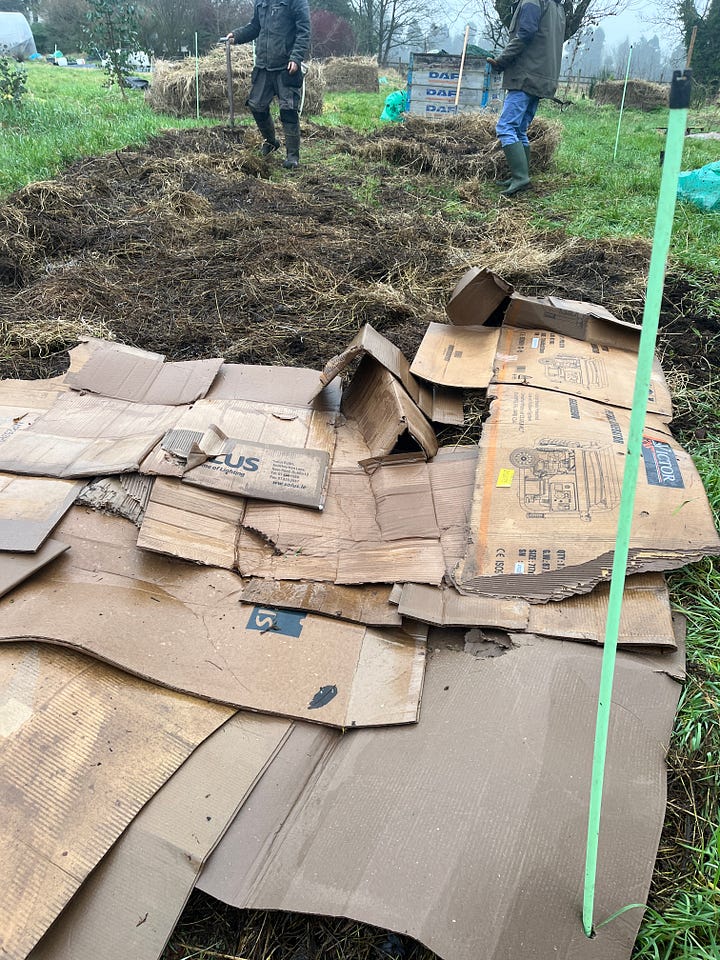
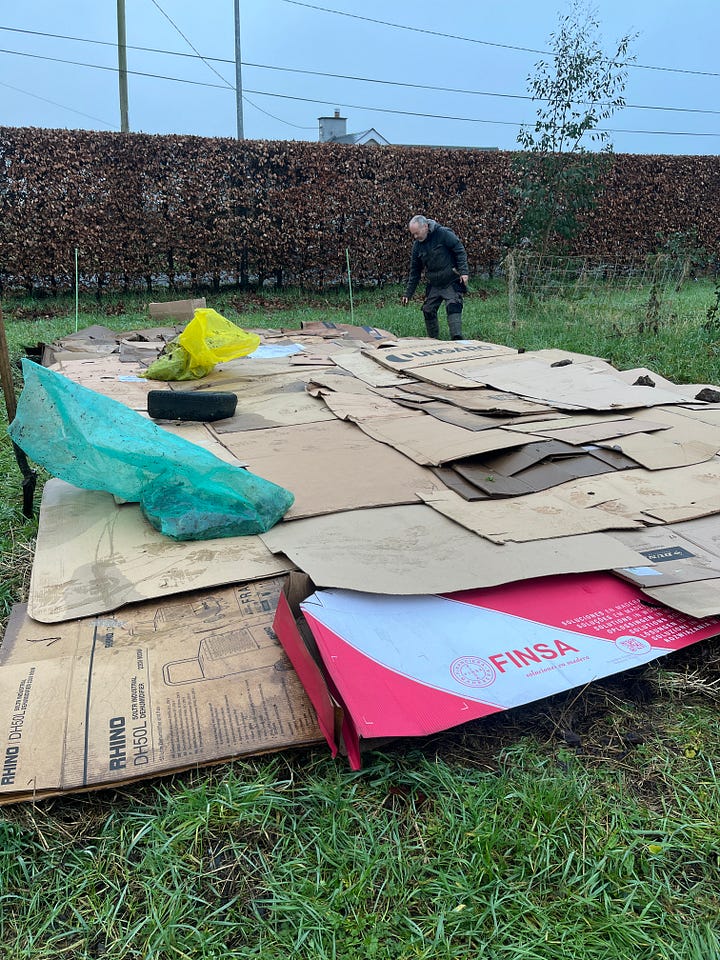
Our 60 meters of native hedge is doing well - I did a bit of trimming to encourage bushiness, and we will use more of the composted grass to mulch it. But at this stage - year 3 if I remember correctly- it’s well established and doesn’t need a huge amount of care. That said, it’s very satisfying to clean up the base and pull nettles and other weeds out and leave it looking clean, though from a biodiversity point of view we may be doing more harm than good.
There’s a good stand of autumn fruiting raspberry that needed to be pruned back - Brian took his scythe to the stand and it was all accomplished in jig time. Another excellent use of the scythe discovered.
Workshops
I was delighted to be asked to run a Brigid’s cross the the Women’s Community Project here in Mullingar. We had a lively discussion of Brigid the goddess and St. Brigid and her miracles, and then we went on to make crosses from freshly scythed rushes. My mother was a great woman to make Brigid’s crosses, hence I have been making them myself for decades, so I was delighted to pass on this heritage skills to an interested bunch. A few people had the skill, a few more picked it up quickly, and the rest had plenty of help from their peers.
You may remember or maybe you attended some of the Sustainability Horizons workshop that we ran in Castlepollard library. We have taken the ideas and the learnings from that project and we will be running 2 workshops in the same theme in Moate library - Feb 15th and March 1st, with an exhibition on March 8th. The first workshop is called “Material World” - we will talk about the global fashion industry, especially fitting in Moate where they have had great success with Junk Kouture. Building on that knowledge, we will then dive into creativity and create a rag doll with lots of support from Teresa Doyle (and myself) .
On March 1st, we will revisit ‘Flower Power’ - looking at the global flower industry with a critical eye, and then creating an upcycled flower vase. This workshop was really popular the last time around, so book your place soon!
This project will culminate in an exhibition of the work in Moate library at 6:30pm Thursday March 8th.
I’m also working on an application for Creative Westmeath funding - hopefully I’ll be able to bring some new and exciting workshops to Westmeath.
Flower Farming
I love ranunculus - such a delight to have in bouquets in the Spring. Because of the tunnel project, I didn’t have huge amount of room to plant all the corms inside, so I planted some outside in large containers. They are sheltered by the house, on an east facing wall - and even though there has been some snow, they are doing very well. This is the area where my outside tomatoes flourished last year so I guess it’s a good spot.
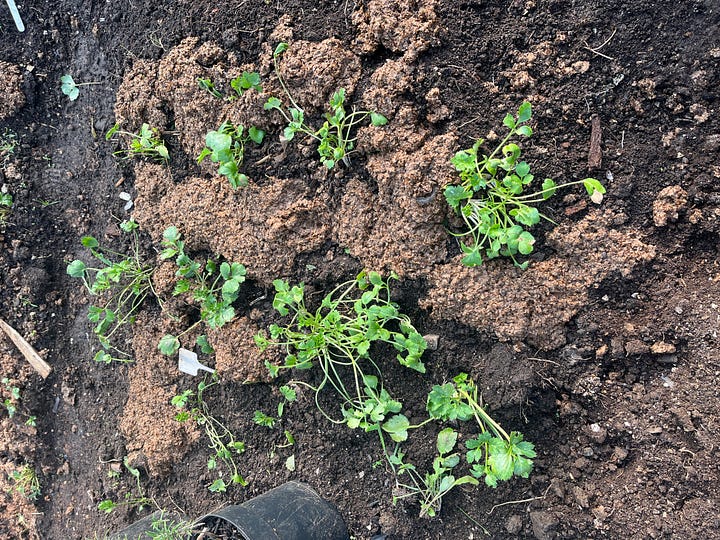
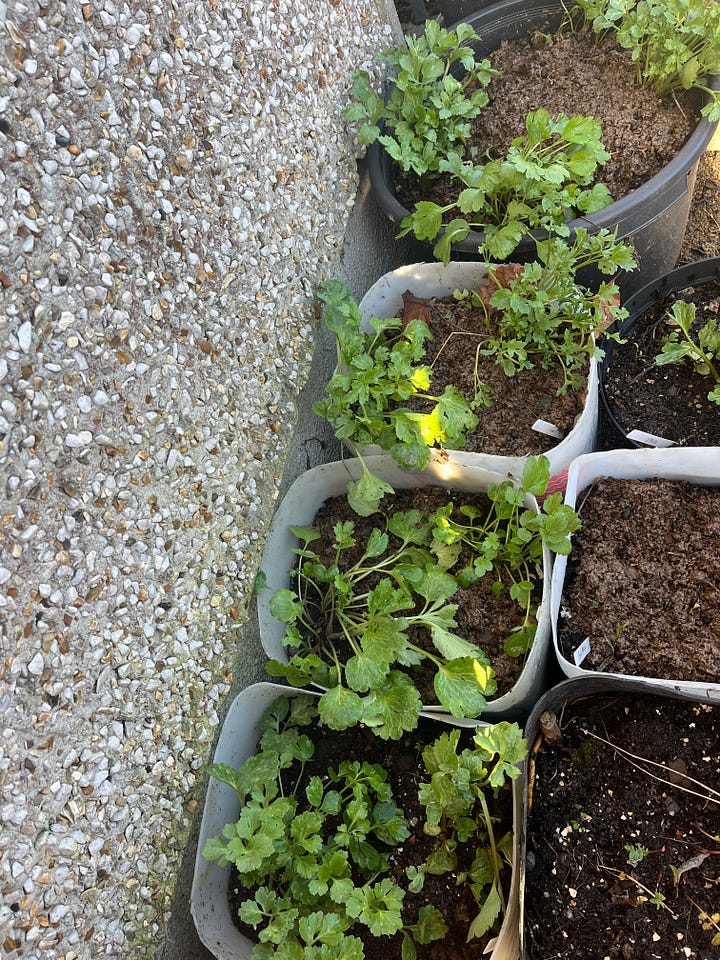
I found a few people to take some of the extra organic material coming out of the tunnel off my hands - which is great because I don’t have room to turn around at the minute, and at least one compost bin needs to be emptied. A good problem to have I guess!
My autumn sown sweet peas are doing well- they were moved to the tunnel as soon as they germinated (in the house). They are doing very well - in fact they need a bit of pinching out to make them a bit bushier. They really don’t mind being cold, but if you have them somewhere warm with low light (an inside windowsill) they will get very leggy, and that’s not a desirable outcome. Much better to have them outside even if you don’t have a tunnel or greenhouse. Planted in toilet rolls to minimise root disturbance when they are moved to their permanent home.
I didn’t plant any seeds yet this year- I’ll be targeting chillis and aubergines in early February, and maybe a few perennials that need cold weather stratification - lupins, delphinium to name a few.
Learning
I have been deepening my knowledge of bumblebees and solitary nesting bees. I have been working on signage and a website for the new bee pollinator trail which will be installed in Streamstown on the greenway very soon - hopefully by the start of February. It’s going to be an exciting addition to what is already an amazing resource. We did a user experience test out there in mid-January - thanks to anyone who came out for that. Great to have the material validated before we press the print button. Here’s a link to the website which is still a work in progress - all feedback is welcome! There will be lots more in future newsletters about this project, I promise!
Upcoming events
Sign up here for “Material World” , Feb 15th. You can also come to ‘Flower Power’ on March 1st. Both workshops are free and all materials will be provided.
Last time around a good few of you hit the like button - which is immediately gratifying - a little endorphin rush for me, thank you and please continue!
And this month’s song is a very old one - but fitting since it’s bare root season. More trees please!

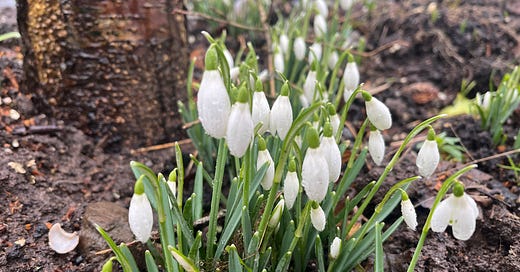



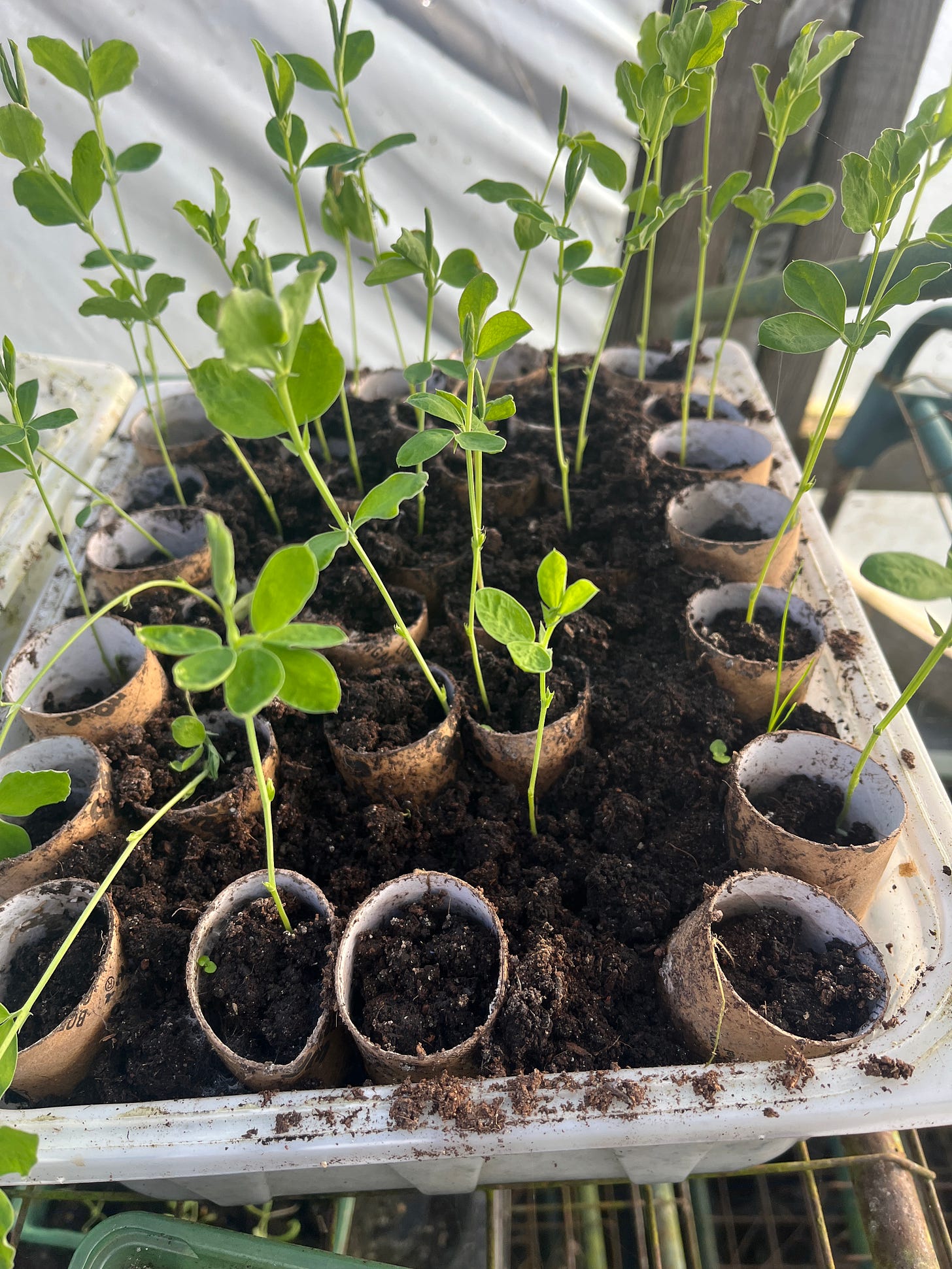
Great song choice Anna 👏🏻 👏🏻 We are looking forward to planting some bare root trees here this weekend.